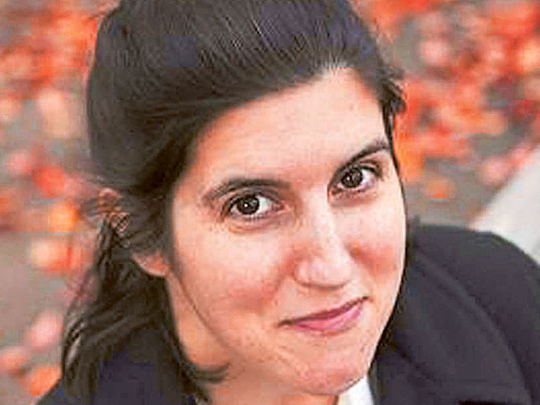
It takes confidence — some might even say hubris — to rewrite one of the most beloved novels in the English canon.
So Curtis Sittenfeld was prepared for a backlash when word got out that she was writing a modern-day version of Jane Austen’s classic “Pride and Prejudice”. The response from some die-hard Austen fans was swift and predictably brutal.
“There have been some early reviews that say, ‘Curtis Sittenfeld is no Jane Austen’,” Sittenfeld said. “And I’m like, ‘Clearly’.”
Sittenfeld, author of the best-selling novels “Prep” and “American Wife”, seems almost sheepish when discussing the daunting task she had set for herself. Her novel “Eligible” is the latest book in the Austen Project, a series that pairs contemporary novelists with Austen’s six works. So far, there have been versions of “Emma”, by Alexander McCall Smith; “Northanger Abbey”, by Scottish crime novelist Val McDermid; and “Sense & Sensibility”, by Joanna Trollope.
But updating “Pride and Prejudice” poses a unique challenge. Of all of Austen’s works, it is far and away the most popular. It has been adapted into dozens of spinoff books, including murder mysteries (P.D. James’s lurid “Death Comes to Pemberley”) and horror stories (Seth Grahame-Smith’s blood-soaked parody “Pride and Prejudice and Zombies”). There are “Pride and Prejudice”-theme books for every age group and demographic, including cookbooks, colouring books, young adult novels, board books for toddlers and comic books.
“The characters and plot are kind of in our air and water by now,” said Juliette Wells, author of “Everybody’s Jane: Austen in the Popular Imagination”.
So what led Sittenfeld, 40, an acclaimed writer who has published four earlier novels, to enter the hypersaturated market for Jane Austen fan fiction?
Like millions of other readers, she happens to be a huge Austen fan. And while she knew that rewriting “Pride and Prejudice” was professionally risky, she was driven partly by the same impulse that compelled devoted Austenphiles to reread the novel dozens of times: she wanted to spend more time with the characters.
“I see ‘Eligible’ as a homage, and I see ‘Pride and Prejudice’ as a perfect book,” she said. “You can dispute whether this project is a good idea, but you can’t dispute my fondness for the novel.”
As if to prove the depth of her affection, Sittenfeld noted during a recent interview at a Midtown Manhattan café that she was carrying a copy of the novel in her purse, “in case we have a ‘Pride and Prejudice’ emergency,” she explained. “You never know.”
There were no emergencies. But it quickly became evident that Sittenfeld could probably handle any urgent “Pride and Prejudice” questions without consulting the source. She more or less committed the plot to memory when she carefully mapped out the novel’s 61 chapters, in an effort to create a blueprint of sorts for her own version.
Like the 1813 original, Sittenfeld’s novel features a headstrong heroine named Elizabeth Bennet, whose nervous, overbearing mother is obsessed with marrying off her and her sisters. Lizzy’s vapid, flirtatious younger siblings, Kitty and Lydia, are an embarrassment to the family, while her older sister, Jane, is approaching spinsterhood. A rich single man, Bingley, comes to town and takes a liking to Jane, while Lizzy takes an instant dislike to Bingley’s even richer friend, the aloof Fitzwilliam Darcy. Of course, Lizzy and Darcy eventually realise that they are perfect for each other.
“Eligible” unfolds in 2013 in Cincinnati, where Liz, a journalist for a women’s magazine, and Jane, a yoga instructor, have returned home after their father has suffered a heart attack. Bingley, the handsome scion of a wealthy local family, is in town licking his wounds after a humiliating appearance on “Eligible”, a “Bachelor”-like reality dating show. Darcy is a taciturn neurosurgeon, who strikes Liz as unbearably condescending.
The novel has already proved polarising among Austen fans. “Sadly disappointing, this book is just trying to cash in on the popularity of Austen’s characters,” one angry reader wrote on Goodreads. A critic for “Kirkus Reviews” warned, “Don’t expect to get the same level of romantics and Darcy-inflicted swoon that make the original untouchable.”
But others have praised Sittenfeld for channelling Austen’s biting wit and razor-sharp observations about gender, class and money, and for putting her own satirical spin on the timeless plot.
“Reboots are tremendously tricky, and almost the only thing that would induce me to read a reboot of ‘Pride and Prejudice’ is Curtis Sittenfeld’s name on the cover,” Rebecca Mead, a writer for “The New Yorker”, said in an e-mail.
Certainly, Sittenfeld and her idol share fragments of literary DNA. Both write novels of manners featuring smart female protagonists who struggle to navigate the fault lines of gender identity, courtship and social class, themes Sittenfeld explored in her 2005 debut novel, “Prep”.
Sittenfeld also shares some of the heroine’s pluck and dry humour, as well as her first name. (Her full name is Elizabeth Curtis Sittenfeld.) She grew up in Cincinnati, where her mother taught art history and worked as a school librarian, and her father was an investment adviser. She attended Groton, the Massachusetts boarding school, an experience she drew on for “Prep”. She was a junior there when she first read “Pride and Prejudice”.
“It contains the best version of all the things Austen does well,” she said. “The dialogue is magnificent; the humour is so sharp; the commentary on class is so astute.”
Initially, when an editor from Borough Press, an imprint of HarperCollins UK, approached Sittenfeld in 2011 about rewriting the novel as part of the Austen Project, she was sceptical.
“I wondered if it would be cheesy,” said Sittenfeld, who lives in St Louis. “But you can’t live your life worrying about being cheesy.”
At first, she tried to write a scene-for-scene re-creation of Austen’s novel but found the process too constricting. She realised that it would be unrealistic for Darcy to propose to Liz before they had even dated. She makes Liz 38, rather than 20, an absurdly young age for a contemporary woman to worry about her marital status. And she split one of Austen’s original characters, the charming but deceitful Wickham, into two characters: Jasper Wick, a married rogue who has been stringing Liz along, and Ham, Lydia’s boyfriend.
While Sittenfeld risks rankling Austen purists, her looser approach also separates “Eligible” from other, less successful Austen updates that were unswervingly loyal to the original stories.
“One of the pitfalls these books fall into is being too faithful to Jane Austen,” said Deborah Yaffe, author of “Among the Janeites: A Journey Through the World of Jane Austen Fandom”. “Not everyone is an undiscriminating consumer of anything that has Jane Austen’s name on it.”
Lately, there have been scattered signs of Austen fatigue. Sales for some recent Austen updates have been tepid. Trollope’s modern-day “Sense & Sensibility”, which was published in 2013, has sold just 5,100 copies in the United States, while McDermid’s contemporary take on “Northanger Abbey” sold just 2,800 copies, according to Nielsen, which tracks around 85 per cent of print book sales.
But the Jane Austen Industrial Complex still seems pretty robust. Next year is the 200th anniversary of Austen’s death, and scholars and writers are commemorating the occasion with a blizzard of academic books, conferences and exhibitions and a handful of new Austen-derived novels.
Writers and filmmakers are digging deeper into Austen’s body of work to find “fresh” material among her early novellas, unfinished stories and juvenilia. Little, Brown and Co. is publishing Whit Stillman’s novel “Love & Friendship”, which is based on “Lady Susan”, Austen’s little-known epistolary novella. Stillman, who has also adapted the book into a forthcoming feature film, said he chose “Lady Susan” because it felt fresh and relatively untapped.
“There are people groaning about all the Jane Austen adaptations,” Stillman said in an interview. “This was something at the top shelf, catching dust.”
Even Sittenfeld seems a little wary of treating Austen too much like a literary golden goose. A few months ago, she tweeted, “I wonder if Jane Austen ever feels like we take and take and never give.”
–New York Times News Service









